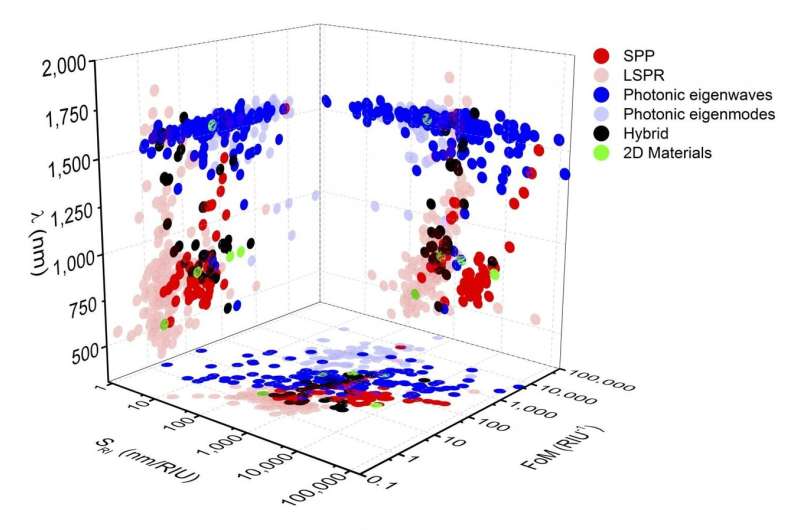Researchers develop novel framework for tracking developments in optical sensors

Plasmonics and photonics have been drawing attention in both academia and industry due to their use in an extensive range of applications, one of which includes optical sensing. The development of optical sensing technology not only contributes to the scientific research community as a versatile tool, but also offers substantial commercial value for smart city and Internet of Things (IOT) applications due to its energy efficiency, lightweight, small size and suitability for remote sensing. Reinforcing its significance, Scientific American identified plasmonic sensing as one of the top 10 emerging technologies of 2018.
Various optical sensing mechanisms and sensor structures have been proposed and demonstrated in the past few decades. Almost every new sensing mechanism or sensor configuration would be explored regularly to test its sensing ability. However, information on the gap between the experimental realisation and theoretical limits, difference between metal-based plasmonic sensors and dielectric-based photonic sensors, and discrimination between propagating eigenwave and localised eigenmode structures was not readily available.
Researchers from the Singapore University of Technology and Design (SUTD), Singapore, Agency for Science, Technology and Research (A*STAR), Singapore, and Austrian Institute of Technology, Austria, conducted extensive literature research, systematically summarised and compared the sensing abilities of these optical refractive index sensors according to their sensitivities and figure of merits. A 3-D technology map was then established (see figure 1) to define the standard and development trend for optical refractive index sensors using plasmonic and photonic structures.
In particular, the following four common types of label-free optical refractive index sensors using plasmonic and photonic structures were reviewed:
- Metal-based propagating plasmonic eigenwave sensors, such as prism-coupled surface plasmon polariton sensor;
- Metal-based localised plasmonic eigenmode sensor, such as metallic nanoparticle-based localised surface plasmon resonance sensors;
- Dielectric-based propagating photonic eigenwave sensors, such as fiber interferometers;
- Dielectric-based localised photonic eigenmode sensors, such as photonic crystal cavities.
Additionally, more advanced hybrid refractive index sensors such as Fano resonance sensors and 2-D materials integrated plasmonic and photonic sensors were included in the review.
"This technology map, just like a searchlight, clearly indicates the sensing ability, merits and shortcomings of different categories of optical refractive index sensors for researchers in the field," said first-author Yi Xu, Ph.D. student from SUTD and Institute of High Performance Computing (IHPC), A*STAR.
Any new developed optical refractive index sensors can be added to this technology map to compare their sensing abilities with prior works. The continuous addition of new plasmonic and photonic refractive index sensors will enrich the technology map, thus providing a benchmark for this rapid development of optical refractive index sensors.
"Bearing this technology map in mind and thoroughly understanding the merits, limitations, mechanisms and development trends of different categories of RI sensors, together, we can advance the field more effectively," said co-corresponding author and Ph.D. co-advisor, Dr. Lin Wu, IHPC, A*STAR.
With the technology map, various optical refractive index sensors could be better selected according to different applications. "We believe such a comprehensive review on optical refractive index sensors with plasmonic and photonic structures will attract much attention in the research communities, which will help engineers to use the right sensors for the design of sub-systems in smart city and IOT," said SUTD Professor Ricky Ang, co-corresponding author and Ph.D. advisor.
More information: Yi Xu et al, Optical Refractive Index Sensors with Plasmonic and Photonic Structures: Promising and Inconvenient Truth, Advanced Optical Materials (2019). DOI: 10.1002/adom.201801433
Journal information: Advanced Optical Materials
Provided by Singapore University of Technology and Design



















